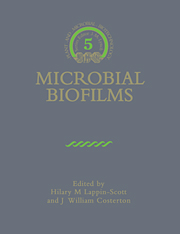Book contents
- Frontmatter
- Contents
- List of Contributors
- Series Preface
- Introduction to Microbial Biofilms
- Part I Structure, Physiology and Ecology of Biofilms
- Part II Biofilms and Inert Surfaces
- 7 Biofilm Development in Purified Water Systems
- 8 Mineralized Bacterial Biofilms in Sulphide Tailings and in Acid Mine Drainage Systems
- 9 Biofilms and Microbially Influenced Corrosion
- 10 Microbial Consortia in Industrial Wastewater Treatment
- 11 Heterogeneous Mosiac Biofilm – A Haven for Waterborne Pathogens
- Part III Biofilms on the Surfaces of Living Cells
- Index
10 - Microbial Consortia in Industrial Wastewater Treatment
Published online by Cambridge University Press: 24 November 2009
- Frontmatter
- Contents
- List of Contributors
- Series Preface
- Introduction to Microbial Biofilms
- Part I Structure, Physiology and Ecology of Biofilms
- Part II Biofilms and Inert Surfaces
- 7 Biofilm Development in Purified Water Systems
- 8 Mineralized Bacterial Biofilms in Sulphide Tailings and in Acid Mine Drainage Systems
- 9 Biofilms and Microbially Influenced Corrosion
- 10 Microbial Consortia in Industrial Wastewater Treatment
- 11 Heterogeneous Mosiac Biofilm – A Haven for Waterborne Pathogens
- Part III Biofilms on the Surfaces of Living Cells
- Index
Summary
Introduction
Wastewater treatment is an essential component of our social order, for without it we soon find our communities suffering from waterborne disease, and our ecosystems suffering unwanted change. For over a century wastewater treatment systems have been designed to increase microbial growth in order to remove organic carbon and other nutrients, while limiting the release of suspended solids into receiving waters. Optimizing design parameters for these goals has been a successful strategy for many conventional wastewaters. However, in the past two decades we have confronted an increasing variety of non-conventional wastewaters in the form of chemical and industrial process effluents and landfill leachates. Legislation has been enacted in many countries that specifies the levels of toxic organic and inorganic chemicals that may be released into the environment. For example, in Canada the provinces of British Columbia, Ontario and Quebec have enacted strict regulations dealing with the discharge of chlorinated organics in pulp mill wastewaters. The long term cost to Canadian industry of this legislation plus proposed new regulations further limiting the chronic toxicity of wastewater discharges will be in the billions of dollars. These costs are already exerting pressure on the industries concerned to solve toxicity problems in the most efficient way possible.
There are three components to a successful toxic wastewater treatment process: knowledge of the nature of the toxic chemicals, an understanding of the concentrations of these chemicals that affect target organisms in receiving waters, and knowledge of the conditions required for growth of toxin degrading microorganisms in the treatment system. The first two of these have been placed on a sound scientific footing using the techniques of analytical chemistry and toxicology.
- Type
- Chapter
- Information
- Microbial Biofilms , pp. 183 - 195Publisher: Cambridge University PressPrint publication year: 1995
- 4
- Cited by



